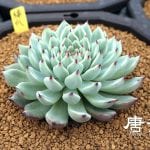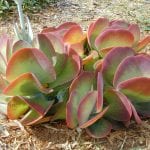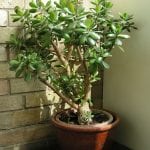
echeveria lilac
All the crassulaceae They are plants with great ornamental value that have characteristics that make them unique. Although they are often confused with cacti, in reality they have nothing to do with them, since their method of adaptation to the environment is different.
There are different genres, each more interesting. If you want to know more about them, Next I will tell you several things that will help you learn to identify them.
What is a biosimilar

Crassula perforata
Crassulaceae are very characteristic plants, which they have simple leaves that sprout from a stem that can be more or less thick depending on the species. These can be opposite, alternate, or basal rosette, of colors that go from green to red, passing through bluish, pink or bicolor.
They usually bloom in spring, but there are some, like the Echeveria, that prefer to do it in the middle of summer and even early fall. The flowers are hermaphroditic and appear gathered in inflorescences, often cymose.. And finally, the fruits are capsular or follicular.
CAM metabolism of crassulaceae
Living in habitats where temperatures are very high, often above 40ºC during the day, they have evolved to do as little as possible while the sun is out. For it, perform photosynthesis in two separate phases: the light in which malic acid is released and supplied for the formation of carbohydrates, and the dark in which they absorb carbon dioxide.
Which are?
They are all the plants that belong to these botanical families:
- Crassuloideae
- Cotyledonoideae
- echeverioideae
- Kalanchoideae
- Sedoideae
- sempervivoideae
To make it easier for you to identify them, here is a photo gallery:
- Cotyledon tomentosa 'Ladysmithiensis'
- Echeveria cuspidata var. Zaragozae
- Sempervivum 'Dark Beauty'
- Sedum rubrotinctum
- Crassula ovata
How are they cared for?
If you would like to have a copy, we recommend providing the following care:
- Location: outside, in full sun. Of course, if they have never been exposed to the star king, you have to get used to them little by little and gradually to prevent them from burning.
- Earth:
- Pot: universal growing substrate mixed with perlite in equal parts.
- Garden: it is indifferent as long as it has good drainage.
- Irrigation: 2-3 times a week in summer, and every 10-15 days the rest of the year.
- Subscriber: from spring to summer with a fertilizer for cacti and other succulents, following the instructions specified on the package.
- Planting or transplanting time: in spring. If it is potted, they must be transplanted every 2 years.
- Multiplication: by seeds or stem cuttings in spring-summer. The Echeveria also by cuttings of leaves.
- Rusticity: most do not support frost. Maybe up to -2ºC as long as they are punctual. In case of doubt, contact us.
What did you think of the crassulaceae?






Thank you very much Mónica Sánchez, you provide us with concise and relevant information.
We're glad you found it interesting, Alan. 🙂